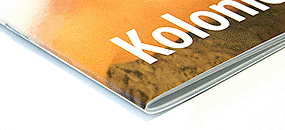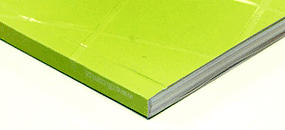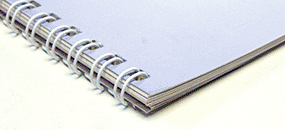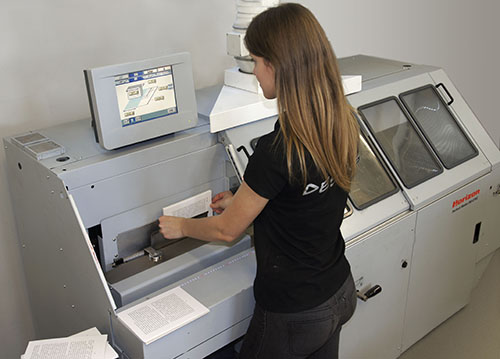 The binding is sewn with wire
The binding is sewn with wire Glued binding
Glued binding Spiral binding
Spiral binding
Binding:
Saddle Stitched
Signatures (each with 4 pages) are folded in half and joined with wire (staples). Optionally, the staples can have loops allowing the catalog/book to be placed in a binder.
The spine is semi-circular and does not lie completely flat. This binding is used for publications with a maximum of 60-80 pages (depending on paper thickness).
The cover is soft (flexible) with a weight of 250-350g (similar to business card stiffness).
Perfect Bound Softcover
Single sheets along with the cover are joined using hot melt or PUR adhesive. The spine is rectangular and lies completely flat. This binding is used for publications with more than 30 pages. The wider the spine, the better the book opens (a wide spine that curves into an arch improves the book's opening characteristics). The cover is soft (flexible) with a weight of 250-350g (similar to business card stiffness).
Sewn and Perfect Bound Softcover
Signatures (each with 4 pages) are folded in half and joined with wire or thread to form booklets, usually with 16 pages. Then, various booklets are glued together using adhesive to form a block. The spine is rectangular and lies completely flat. This binding is used for publications with more than 32 pages. The number of pages must be divisible by 4. This type of binding is characterized by good openability regardless of page volume. The cover is soft (flexible) with a weight of 250-350g (similar to business card stiffness).
Perfect Bound Hardcover
Description is the same as "Perfect Bound Softcover" but the cover is cardboard - hard (not flexible) with a thickness of about 2 mm, similar to a binder. Inside, the cover has an endpaper that covers the first page of the cover and the first page of the text block.
Sewn and Perfect Bound Hardcover
Description is the same as "Sewn and Perfect Bound Softcover" but the cover is cardboard - hard (not flexible) with a thickness of about 2 mm, similar to a binder. Inside, the cover has an endpaper that covers the first page of the cover and the first page of the text block.
Spiral Bound
Single sheets along with the cover are joined with a metal spiral. The spine is formed by the spiral, and the book lies completely flat. This binding is used for publications with more than 8 pages, commonly used for binding menus in restaurants as well as catalogs subject to intensive daily use. The main advantage of this binding is its ease of opening completely flat and durability. Pages have holes and move easily on the spiral, so no forces act on the spine as with other bindings. The cover is soft (flexible) with a weight of 250-350g (similar to business card stiffness).











